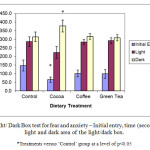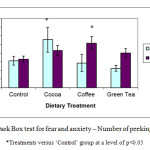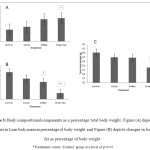Introduction
More beverages are now being included in food products. Green tea cakes (i.e. mocha cake from Japan, Korea and China), green tea and coffee ice creams, chocolate and coffee cake are notable examples of the use of anti-oxidant containing beverages included in a food format, typically added at 0.5-2% of the food weight. Further, many health-food supplements/ nutraceuticals are being sold promoting the effect of the beverage presented as a dry powder i.e. green tea tablets, green coffee bean or cocoa extract. These extracts are noted for their lipolysis effects. The question to be answered is; are the health effects (i.e. lipolytic, anxiolytic effect) seen in the consumption of these beverages the same as eating them? A diet high in saturated fats has been linked to numerous physiological health concerns, including obesity and type II diabetes (Bjermo et. al.,2012), but also depression and anxiety, where consumption of a vegetarian diet may improve mood (Beezhold & Johnston 2012). The effect of consumption of different beverages on behaviour (i.e. anxiety, depression) has also been documented to be both beneficial and adverse (i.e. inclusion of green tea; anxiolytic properties) (Vignes et. al.,2006) and cocoa drink; migrane/ headaches (Savi et. al.,2002). During this study, the effect of a high-fat (i.e. butter fat) diet and certain beverages containing antioxidants were added to a diet and fed to mice that have a pre-dependency to obesity. Obesity has been linked to mood and anxiety disorders possibly through the increase in protein oxidation in the frontal cortex (Souza et. al.,2007). Further, weight loss is associated with positive changes in psychological well-being (Swencionis et. al.,2013), which may be personal perception or related to a physiological function (i.e. higher lean mass) or direct effect dietary phytochemical components (i.e. GABA(A) receptors and EGCG found in green tea). It has been observed that anti-oxidants (i.e. chlorogenic acid, catechins) may also have anxiolytic effects (Bouayed et. al.,2007). Moreover, L-theanine found in green tea has been observed to have relaxing effects in humans experiencing anticipated anxiety, but not a direct anxiolytic effect (Lu et. al.,2004). Moreover, it is also possible higher lean mass may reduce the incidence of anxiety like behaviour as a secondary effect of green tea consumption.
The aim of the study was to observe if feeding green tea and other anti-oxidant containing beverages as wholefoods in a high fat diet changes behaviour, especially fear and anxiety in mice after the confounding factor of obesity was removed.
Methods
Animal Studies
Prior to experimentation, La Trobe University animal ethics committee approval was granted. All experiments were performed with mice of 4 weeks of age (21–22 g). Adult C57BL/6J mice were used as their phenotype is obesity prone (Alexander 2006). The mice were n = 48 mice divided equally into four dietary treatment groups. The mouse were housed in Perspex boxes measuring (0.7m x 0.25m x 0.25m), with water and food recorded and replenished daily. Their weight was determined bi-weekly. At the end of the 18 week experiment, animals were sacrificed via injection of Nembutal (200mg/kg).
Diets
There were four diets composed. The standard diet was a 21% fat, 19% protein, 49% carbohydrate, 0.15% cholesterol semi-pure rodent diet (Specialty Feeds, WA, Australia). The other four diets consisted of the standard diet with the exception that they contained 2% of the following; bournville cocoa (Cadbury, TAS, Australia), coffee (Vittoria, NSW, Australia) and powdered Japanese green tea (Good Young, TAIPEI, Taiwan) in replacement for 2% carbohydrate (i.e. 34.1% instead of 36.1% sucrose used). For a more detailed outline of dietary composition, please see table 1 in appendices.
Light/ Dark Box test for anxiety
At week 15 of the study, the mice were placed in a wooden box with two domains; total; 43cm (h) x 27.2cm (w). The light chamber measured 19.5cm x 27.2cm and was uncovered. On the other hand, the dark chamber measured 9.3cm x 27.2cm and was covered with a lid. The light source was 40cm away from the entrance to the dark area, and emitted a light source of PAR = 4.2 at the mouse (i.e. PAR – Photosynthetic Active Radiation units µmol/m2/s). The mice were initially placed inside the light area of the box and were video monitored for 10 minutes whilst in silence in an enclosed room. They were monitored for initial entry into dark area, the number of entries into either section (re-entries) or other behavioural characteristics were recorded.
Statistical Analysis
Statistical Product and Service Solutions (SPSS) software (Version 12; Chicago, IL, USA) was used for statistical analysis. A one-way ANOVA test at a p<0.05 and
P<0.01 was applied.
Results
The ingestion of 2% cocoa with a high fat, high carbohydrate diet causes anxiety-like behaviour
As it can be seen from figure 1, the cocoa group display increased (p<0.05) anxiety behaviour as demonstrated by their total time spent in the dark box and peeking events.
 |
Figure 1: Light/ Dark Box test for fear and anxiety – Initial entry, time (seconds) spent in the light and dark area of the light/dark box. Click here to View figure |
The ingestion of 2% coffee causes agitation and re-entries from light to dark box areas
As displayed in figure 2 the coffee group had increased (p<0.05) re-entries from the light to dark area and thus agitation.
 |
Figure 2: Light/ Dark Box test for fear and anxiety – Number of peeking events and re-entries. Click here to View figure |
The ingestion of 2% green tea did not cause significant increase in peeking nor increased re-entry from light to dark box areas
As displayed in figure 2 the green tea group had lower but non-significant peeking events from the light to dark area when compared to the coffee and cocoa groups and thus displayed non-significant reduced anxiety-like behaviour.
The ingestion of 2% green tea reduces body weight, adiposity and increase lean mass
As displayed in figure 3, consumption of 2% green tea in a high fat diet results in increased lean mass and reduced body weight and adipose tissue.
 |
Figure 3: Body compositional components as a percentage total body weight. Figure (A) depicts changes in Lean body mass as percentage of body weight and Figure (B) depicts changes in body fat as percentage of body weight Click here to View figure |
Discussion
Mice who display fear/ anxiety migrate towards darker rather than lighter areas (Heredia et. al.,2013), as evident in the cocoa group, with agitation a symptom of anxiety (i.e. coffee group). It may be probable that the phytochemical caffeine may be responsible for this observation, but the anxiety like behavior was not seen in green tea (i.e. contains caffiene) group with intake on a high fat diet. Different dietary influences give rise to modulation in behavior; as observed in the cocoa consumption (Dallard et. al.,2001), who observed anxiety disorder in chronic cocoa users. Phytochemicals in cocoa include theaflavin, epigallocatechin gallate, resveratrol, and procyanidin, of which the former two are also present in green tea as well. This would suggest that another phytochemical in green tea is protecting the mice against a rise in anxiety like behavior. Although, 2% green tea in the diet did not significant reduce anxiety like behavior, there was no difference with the control animals. On the contrary, the present results exemplify a 2% shift in a diet can cause a large shift in behavior, in particular agitation (i.e. significantly high number of re-entries seen in figure 2 in the coffee group), caused by coffee consumption in a high fat and sucrose diet which is symptomatic of anxiety like behavior. The agitation behavior seen in the coffee group as demonstrated by their high number (p<0.05) of re-entries may be attributable to the caffeine content of the diet and absence of a regulatory phytochemical that maybe present in green tea. Further, caffeine consumption has been linked to restless leg syndrome/ anxious depressive disorder (Lutz 1978), however, the chlorogenic acid content of coffee may counteract this effect as Bouayed et. al.,2007 observed that chlorogenic acid (dose 20 mg/kg) decreases anxiety-related behaviors (i.e. activation of benzodiazepine receptor) and is also beneficial in oxidative stress. The green tea group did not display the same level of light avoidance as the other groups concerned & hence anxiety/ fear was not present in that group (i.e. as per the cocoa group) as they displayed the lowest number of peeking events, and lowest time spent in the light section. Although non-significant, these findings are aligned with Vignes et. al.,2006 who showed that EGCG (polyphenol) found in green tea are also ligands for the GABA(A) receptor benzodiazepine site (i.e. sedative properties), and that EGCG can induce anxiolytic activity, resulting from an interaction with GABA(A) receptors (Vignes et. al.,2006), yet this finding was rebuked by (Heese et. al.,2009).
Further, there is an observed association between specific genes involved in lower risk assessment behaviour, oxidative stress metabolism, and anxiety-like behaviour/ symptoms (Souza et. al.,2007). A series of studies have observed that migraine and headache were attributed to many dietary influences but mainly chocolate (i.e. cocoa, butter fat, sucrose), oral contraceptives, and cheese (Savi et. al.,2002; Wöber et. al.,2006). Schuman et. al.,1987 observed that some individuals who “self-medicating” with chocolate were more likely to have personality traits associated with an atypical depressive syndrome (i.e. hysteroid dysphoria). Further, it has been observed that craving for chocolate produces increased activation of the medial orbito-frontal cortex and ventral striatum (Rolls and McCabe 2007). In major depression, there is reduced volume (i.e. reduced density of neurons and glia) in the 32% smaller medial orbitofrontal (gyrus rectus) cortex (Bremmer et. al.,2002), as the OFC appears cytoarchitectonically distinct functionally with respect to mood regulation, as depression severity correlates inversely with physiological activity in parts of the posterior lateral and medial OFC (Drevets 2007).The mechanisms for cocoa to evoke similar psychopharmacologic and behavioral reactions as drug, alcohol addicted individuals may be caused by the content of fat, sugar, texture, and aroma (Bruinsma and Taren 1999). Other researchers suggest that chocolate contains several biologically active constituents (methylxanthines, biogenic amines, caffeine, phenylethylamine, magnesium and cannabinoid-like fatty acids), all of which potentially cause abnormal behaviours and psychological sensations that parallel those of other addictive substances (Bruinsma and Taren 1999; Benton and Donohoe 1999).
Green tea on the other hand, has been shown to exert anxiolytic and cognitive beneficial effects for the elderly in both animal models and humans. In Wistar rats, orally administered 0.5% green tea extract for eight weeks improved learning and memory significantly with an accompanying decline in cerebrum acetylcholinesterase activity of the older rats when compared with young rats (Kaur et. al.,2008). Moreover, the anxiolytic effects of L-theanine with midazolam, a chief amino acid component of green tea, but not related to the GABAA receptor in Sprague-Dawley rats (Heese et. al. 2009). It may be probable that both L-theanine, unique to green tea is counteracting a significant anxiety like behaviour in the green tea group attributable to caffeine. L-theanine and caffeine have been observed to be responsible for the beneficial effect on cognition and mood mainly via inhibition of blood-pressure increases in high-stress-response adults (Yoto et. al.,2012). However, supplementation of epigallocatechin gallate (EGCG) in schizophrenic patients was not able to significantly reduce psychiatric symptoms in a placebo-controlled pilot study (Loftis et. al.,2013), suggesting the action of a phytochemical other than EGCG or caffiene. It may also be probable that rather than the sole action of a specific phytochemical, the difference in body composition displayed in the green tea group (higher lean tissue mass) as seen in figure 4, may be responsible for the reduced state of anxiety as per observations by Rosmond and Björntorp 1996 who found a higher use of anxiolytics with women of a higher BMI, especially abdominal obesity. Moreover, in patients with metabolic syndrome it has been revealed that total percentage body fat is associated with increased severity of anxiety and also depressive symptoms (i.e. body composition of higher lean mass reduces incident of anxiety/depressive symptoms) (Guedes et. al.,2013).
Lastly, confirmation with physiological markers of stress and anxiety are necessary to support behavioural observations in the mice as cortisol metabolite levels have been observed to be elevated in depression in men, but not related to adiposity (Katz et. al.,2000). Further research is required to elaborate on the anxiolytic effect of green tea phytochemical components in vivo in humans, that may be counter-acting anxiety behaviour seen in caffeine consumption via consumption of beverages such as cocoa or coffee, or in food products as composite foods. Moreover, the influence of body composition is needed, as it appears a lower body fat percentage and secondly a lower BMI confer anxiolytic effect as well and the result may be attributable to body compositional changes rather than the action of specific phytochemicals.
Acknowledgments
The corresponding author would like to thank Professor Richard Weisinger for his selfless donation of research funds, equipment and most of all time to enable this project to be completed.
Declaration of Interest Statement
The corresponding author would like to acknowledge that there was no conflict of interest in funding of this study.
References
- Beezhold, B.L., Johnston, C.S. (2012). Restriction of meat, fish, and poultry in omnivores improves mood: a pilot randomized controlled trial. Nutr J. 11:9. doi: 10.1186/1475-2891-11-9.
CrossRef - Benton, D., Donohoe, R.T. (1999). ‘The effects of nutrients on mood’. Public Health Nutr. 2(3A), 403-9.
CrossRef - Bjermo, H., Iggman, D., Kullberg, J., Dahlman, I., Johansson, L., Persson, L., Berglund, J., Pulkki, K., Basu, S., Uusitupa, M., Rudling, M., Arner, P., Cederholm, T., Ahlström, H., Risérus, U. (2012). Effects of n-6 PUFAs compared with SFAs on liver fat, lipoproteins, and inflammation in abdominal obesity: a randomized controlled trial. Am J Clin Nutr. 95(5), 1003-12. doi: 10.3945/ajcn.111.030114.
CrossRef - Bouayed, J., Rammal, H., Dicko, A., Younos, C., Soulimani, R. (2007). ‘Chlorogenic acid, a polyphenol from Prunus domestica (Mirabelle), with coupled anxiolytic and antioxidant effects’. J Neurol Sci.262(1-2), 77-84.
CrossRef - Bremner, J.D., Vythilingam, M., Vermetten, E., Nazeer, A., Adil, J., Khan, S., Staib, L.H., Charney, D.S. (2002). ‘Reduced volume of orbitofrontal cortex in major depression’. Biol Psychiatry. 51(4):273-9.
CrossRef - Bruinsma K, Taren DL. (1999). ‘Chocolate: food or drug?’ J Am Diet Assoc. 99(10), 1249-56.
CrossRef - Dallard, I., Cathebras, P., Sauron, C., Massoubre, C. (2001). ‘Is cocoa a psychotropic drug? Psychopathologic study of a population of subjects self-identified as chocolate addicts’. Encephale. 27(2), 181-6.
- Drevets, W.C. (2007). ‘Orbitofrontal cortex function and structure in depression’. Ann N Y Acad Sci. 21, 499-527.
CrossRef - Guedes, E.P., Madeira, E., Mafort, T.T., Madeira, M., Moreira, R.O., Mendonça, L.M., Godoy-Matos, A.F., Lopes, A.J., Farias, M.L. (2013). Body composition and depressive /anxiety symptoms in overweight and obese individuals with metabolic syndrome. Diabetol Metab Syndr. 5(1), 82.
CrossRef - Heese, T., Jenkinson, J., Love, C., Milam, R., Perkins, L., Adams, C., McCall, S., Ceremuga, T.E. (2009).
- Anxiolytic effects of L-theanine–a component of green tea–when combined with midazolam, in the male Sprague-Dawley rat. AANA J. 77(6), 445-9.
- Heredia L, Torrente M, Colomina MT, Domingo JL (2013). Assessing anxiety in C57BL/6J mice: A pharmacological characterization of the open-field and light/dark tests. J Pharmacol Toxicol Methods. pii: S1056-8719(13)00327-4. doi: 10.1016/j.vascn.2013.12.005.
CrossRef - Katz, J.R., Taylor, N.F., Goodrick, S., Perry, L., Yudkin, J.S., Coppack, S.W. (2000). ‘Central obesity, depression and the hypothalamo-pituitary-adrenal axis in men and postmenopausal women’. Int J Obes Relat Metab Disord. 24(2), 246-51.
CrossRef - Kramer, H. (2006). Obesity and chronic kidney disease. Contrib Nephrol. 151, 1-18.
CrossRef - Kaur, T., Pathak, C.M., Pandhi, P., Khanduja, K.L. (2008). Effects of green tea extract on learning, memory, behavior and acetylcholinesterase activity in young and old male rats. Brain Cogn. 67(1), 25-30.
CrossRef - Loftis, J.M., Wilhelm, C.J., Huckans, M. (2013). Effect of epigallocatechin gallate supplementation in schizophrenia and bipolar disorder: an 8-week, randomized, double-blind, placebo-controlled study. Ther Adv Psychopharmacol. 3(1), 21-7. doi: 10.1177/2045125312464103.
CrossRef - Lu, K., Gray, M.A., Oliver, C., Liley, D.T., Harrison, B.J., Bartholomeusz, C.F., Phan, K.L., Nathan, P.J. (2004). The acute effects of L-theanine in comparison with alprazolam on anticipatory anxiety in humans. Hum Psychopharmacol. 19(7), 457-65.
CrossRef - Lutz. E.G. (1978). ‘Restless legs, anxiety and caffeinism. J Clin Psychiatry. 39(9), 693-8.
- Rosmond, R., Björntorp, P. (1998). Psychiatric ill-health of women and its relationship to obesity and body fat distribution. Obes Res. 6(5), 338-45.
CrossRef - Rolls, E.T., McCabe, C. (2007). ‘Enhanced affective brain representations of chocolate in cravers vs. non-cravers’. Eur J Neurosci. 26(4), 1067-76.
CrossRef - Savi L, Rainero I, Valfrè W, Gentile S, Lo Giudice R, Pinessi L. (2002). ‘Food and headache attacks. A comparison of patients with migraine and tension-type headache’. Panminerva Med. 44(1), 27-31.
- Schuman, M., Gitlin, M.J., Fairbanks, L. (1987). ‘Sweets, chocolate, and atypical depressive traits’. J Nerv Ment Dis. 175(8), 491-5.
CrossRef - Souza, C.G., Moreira, J.D., Siqueira, I.R., Pereira, A.G., Rieger, D.K., Souza, D.O., Souza, T.M., Portela, L.V., Perry, M.L. (2007). ‘Highly palatable diet consumption increases protein oxidation in rat frontal cortex and anxiety-like behavior’. Life Sci. 81(3), 198-203.
CrossRef - Swencionis, C., Wylie-Rosett, J., Lent, M.R., Ginsberg, M., Cimino, C., Wassertheil-Smoller, S., Caban , A., Segal-Isaacson, C.J. (2013). Weight change, psychological well-being, and vitality in adults participating in a cognitive-behavioral weight loss program. Health Psychol. 32(4), 439-46. doi: 10.1037/a0029186.
CrossRef - Vignes, M., Maurice, T., Lanté, F., Nedjar, M., Thethi, K., Guiramand, J., Récasens, M. (2006). ‘Anxiolytic properties of green tea polyphenol (-)-epigallocatechin gallate (EGCG)’. Brain Res. 1110(1), 102-15.
CrossRef - Wöber, C., Holzhammer J, Zeitlhofer J, Wessely P, Wöber-Bingöl C. (2006). ‘Trigger factors of migraine and tension-type headache: experience and knowledge of the patients’. J Headache Pain. 7(4), 188-95.
CrossRef - Yoto A, Motoki M, Murao S, Yokogoshi H. (2012). Effects of L-theanine or caffeine intake on changes in blood pressure under physical and psychological stresses. J Physiol Anthropol. 31:28. doi: 10.1186/1880-6805-31-28.
CrossRef

This work is licensed under a Creative Commons Attribution 4.0 International License.




